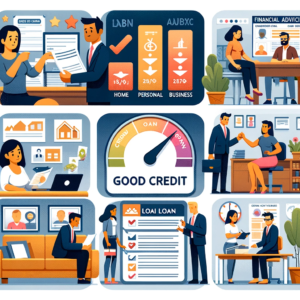Loans play a pivotal role in the financial landscape, offering essential support for individuals and businesses alike. They enable us to make significant purchases, invest in education, cover unexpected expenses, or expand business operations. Understanding the process of acquiring a loan is vital, as it can be a pathway to achieving financial goals or, if mismanaged, a source of financial strain.
Loans come in various forms, each designed to serve specific purposes. For instance, mortgages enable individuals to purchase homes, while student loans make higher education accessible. Personal loans provide flexibility for various personal needs, from consolidating high-interest debt to funding major life events. Business loans, on the other hand, are geared towards funding business ventures, ranging from start-ups to established enterprises looking to grow.
The journey to securing a loan begins with a clear understanding of one’s financial situation and the purpose of the loan. This involves evaluating personal or business finances, understanding credit scores, and identifying the amount needed and its intended use. Such clarity not only guides the choice of loan type but also helps in determining the affordability of the loan.
Creditworthiness is a cornerstone in the lending process. Lenders evaluate an applicant’s credit history to assess the risk involved in lending money. A higher credit score indicates a lower risk to the lender, often resulting in more favorable loan terms, including lower interest rates and more flexible repayment options. Therefore, understanding and potentially improving one’s credit score before applying for a loan is crucial.
The preparation for a loan application also entails gathering necessary documentation. This documentation, which can include proof of income, tax returns, and identification, varies depending on the loan type and lender. Having these documents in order simplifies the application process, making it more streamlined and efficient.
Choosing the right lender is another critical step. With a plethora of lending institutions available, including traditional banks, credit unions, and online lenders, it’s important to compare and contrast their offerings. Factors such as interest rates, fees, and customer service should be carefully considered. Furthermore, understanding the fine print of loan agreements cannot be overstated. It is essential to comprehend the terms and conditions to which one is agreeing, to avoid any surprises during the repayment period.
The application process itself varies from lender to lender but generally involves providing detailed financial information and undergoing a credit check. Honesty and accuracy in this step are paramount. Misrepresentation can lead to legal complications and rejection of the application.
Once a loan is secured, managing repayment effectively becomes the focus. Timely repayment is critical for maintaining a good credit score and avoiding penalties. However, life can bring unexpected financial challenges. In such cases, being proactive and communicating with the lender can provide options like loan restructuring or forbearance, which can help navigate through tough financial times without defaulting on the loan.
In summary, securing a loan is a process that requires careful consideration, preparation, and understanding of various financial factors. Whether it’s for personal use, education, or business, the right approach to getting a loan can be a powerful tool in achieving one’s financial objectives. This article aims to guide you through each step of this process, ensuring that you are well-informed and prepared to make the best decisions for your financial future.

2. Understanding Different Types of Loans

Securing the right type of loan is crucial for meeting specific financial goals. Each loan category is tailored to suit different needs, and understanding them helps in making informed decisions.
Personal Loans: These unsecured loans offer flexibility and are used for various personal expenses, from consolidating debt to funding a dream vacation. Unlike secured loans, they don’t require collateral, but generally have higher interest rates due to the increased risk to the lender.
Home Loans/Mortgages: These are specifically designed for purchasing property and are secured against the home itself. They typically feature lower interest rates and longer repayment periods, making them a cornerstone of long-term financial planning for homeowners.
Auto Loans: Aimed at facilitating vehicle purchases, auto loans are secured against the vehicle. They often have fixed interest rates and a range of term lengths, making them a popular choice for new or used car buyers.
Student Loans: These loans cater to educational expenses, covering tuition and other school-related costs. Available through government programs and private lenders, student loans have varying terms and repayment options, often influenced by the borrower’s educational status and financial need.
Business Loans: Essential for entrepreneurs and businesses, these loans support a range of business activities, from startup costs to expansion efforts. Business loans can be either secured or unsecured, with terms varying widely based on the business’s financial health and the loan’s purpose.
Each loan type serves a unique function in personal and economic growth. From managing personal finances with a personal loan to investing in a dream home or funding education, loans are versatile tools in financial management. Similarly, for business owners, choosing the right business loan can mean the difference between thriving and just surviving in the competitive market.
3. Determining Your Loan Needs
Before embarking on the journey of securing a loan, it’s crucial to have a clear understanding of why you need the loan and how much you need. This self-assessment involves scrutinizing your current financial situation, including income, expenses, savings, and debts. Determining the purpose of your loan – be it for purchasing a home, consolidating debt, financing a car, funding education, or investing in a business – is vital in guiding your decision on the type and amount of loan to pursue.
Budgeting plays a key role here. You need to calculate how much you can comfortably afford to repay each month without straining your finances. This assessment helps in avoiding overborrowing, which can lead to financial difficulties in the future.
4. Checking Your Credit Score

Your credit score is a numerical expression that lenders use to evaluate your creditworthiness. It’s based on your credit history, including past loans, credit card usage, repayment history, and outstanding debts. A higher credit score increases your chances of loan approval and might secure you more favorable loan terms.
Before applying for a loan, obtain a copy of your credit report from the major credit bureaus. Review it for accuracy, and address any errors that might affect your score negatively. If your credit score is lower than desired, consider taking steps to improve it, such as paying down existing debts, making timely bill payments, and reducing your credit utilization ratio.
5. Preparing Your Documentation
When applying for a loan, you’ll be required to submit various documents that allow lenders to assess your financial stability. These typically include proof of income (such as pay stubs or tax returns), proof of identity (like a driver’s license or passport), and proof of residence (such as utility bills or a lease agreement).
For specific loan types, additional documentation may be necessary. For instance, a mortgage application might require property details, and a business loan application might need a business plan. It’s important to have all your documentation organized and ready to streamline the application process.
6. Choosing the Right Lender
Selecting the right lender is as important as choosing the right type of loan. Banks, credit unions, and online lenders each have their unique advantages and disadvantages. While banks might offer more comprehensive services, credit unions could provide lower interest rates. Online lenders often have more lenient approval criteria but might carry higher interest rates or fees.
Research and compare different lenders based on their interest rates, fees, repayment terms, and customer service. Also, read reviews and seek recommendations to ensure that you choose a reputable lender that suits your specific needs.
7. Applying for the Loan

The loan application process varies depending on the lender and type of loan. Generally, it involves filling out an application form and submitting the necessary documentation. The lender will then conduct a credit check and assess your financial situation to determine your eligibility.
During the application process, provide accurate and complete information. Inaccuracies can lead to delays or denial of your application. Some lenders might require a face-to-face interview, while others may handle everything online.
8. Understanding and Negotiating Loan Terms
Once your loan application is approved, you’ll be presented with the loan terms. This includes the interest rate, annual percentage rate (APR), repayment schedule, and any additional fees or penalties.
Understanding these terms is crucial. The APR, for instance, gives a fuller picture of the loan cost, as it includes interest and fees. If something is unclear, don’t hesitate to ask the lender for clarification. Remember, you can negotiate these terms. For example, you might request a lower interest rate or a different repayment schedule.
9. Managing Loan Repayment
After securing the loan, managing repayment is essential to maintain financial stability and a good credit score. Set up a monthly budget that incorporates your loan repayments. Consider setting up automatic payments to avoid missing due dates.
If you face financial difficulties during the repayment period, communicate with your lender immediately. They may offer solutions like loan modification, refinancing, or forbearance, which can help you manage your payments more effectively and avoid defaulting on your loan.